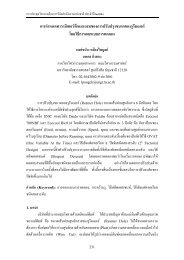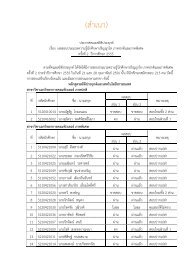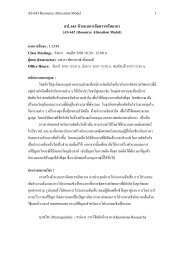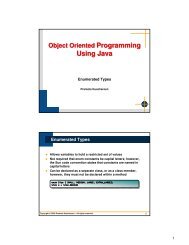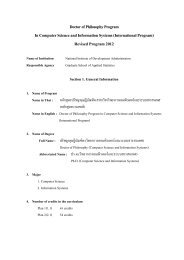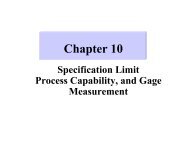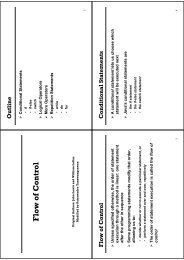ดาวน์โหลด All Proceeding - AS Nida
ดาวน์โหลด All Proceeding - AS Nida
ดาวน์โหลด All Proceeding - AS Nida
Create successful ePaper yourself
Turn your PDF publications into a flip-book with our unique Google optimized e-Paper software.
Fig.1 Process Flow Diagram of Ethanol Process<br />
The ethanol process consists of 4 major unit operations:<br />
2.1.1. Liquefaction & Saccharification<br />
Heat up the mash to 90 o C, liquefying the starch. And<br />
enzymes are added to the mash to convert the starch to dextrose.<br />
2.2.2.Fermentation<br />
Yeast is added to the mash to ferment the sugars. During this<br />
process, the yeast eats the sugars, and in the process produces heat,<br />
ethanol 10%v/v and carbon dioxide.<br />
2.2.3.Distillation<br />
After fermentation the mash is called beer. The beer contains<br />
approximately 10% alcohol by volume and still has many impurities.<br />
These impurities are removed during the distillation phase until pure<br />
alcohol with at least 95% alcohol by volume is obtained. The alcohol<br />
moves on to dehydration. The stillage is processed into distiller grains.<br />
2.2.4.Dehydration<br />
The alcohol circulates through a molecular sieve to capture<br />
the last bit of water. At the end of this process, the ethanol obtains at<br />
least 99.5% v/v.<br />
2.2.5.Storage<br />
Finally, the ethanol is pumped into storage tanks. It is then<br />
ready for shipment to gasoline terminals or retailers.<br />
2.2 Heat distribution in distillation section<br />
For conventional distillation column<br />
Conventionally supplied at the bottom reboiler to evaporate<br />
a liquid mixture and is lost when liquefying the overhead vapor at the<br />
reflux condenser. Actually, heat is added at the highest temperature (T B)<br />
in the column, whereas that is removed at the<br />
157<br />
F, Z F<br />
Heat source<br />
T D1<br />
Tray 1<br />
Feed tray<br />
Tray n<br />
T B1<br />
CW<br />
R 1<br />
Steam<br />
Q C1<br />
Q R1<br />
D 1, x D1<br />
B 1, x B1<br />
Tray 1<br />
Feed tray<br />
Tray n<br />
TB2 Steam<br />
Mash column Rectifying column<br />
T D2<br />
CW<br />
R 2<br />
Q C2<br />
Q R2<br />
D 2, x D2<br />
Fig. 2 Simplified conventional distillation flowsheet<br />
B 2, xB2<br />
lowest temperature (T D). Interestingly, the thermal energy<br />
recovered at the condenser cannot be reused for heating other flows in<br />
the same distillation unit since the temperature of the coolant is usually<br />
sufficiently lower than that of the flows inside the column. Heat is<br />
added at the reboiler and thrown away at the condenser. Actually the<br />
energy is degraded over the temperature range of T B-T D and this is the<br />
prime reason of thermodynamic inefficiency of the conventional<br />
distillation technology [2].<br />
For heat integrated distillation column<br />
Fig. 3 Simplified heat integrated distillation flowsheet<br />
In the HIDiC scheme, the overhead vapor of the rectifying<br />
column enters the reboiler of mash column as heat source. The mash<br />
feed is preheated by vapor of mash column before entering to mash<br />
column. So steam and cooling water consumption can be saved.




